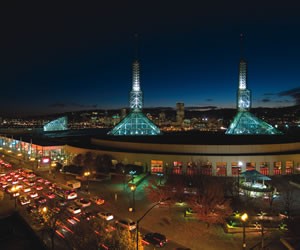From Pittsburgh, Pa., to Portland, Ore., and many points in between, convention center kitchens have been undergoing a culinary revolution in recent years. The concept of meals for the masses is out. Restaurant-style upscale cuisine is in—and the more locally sourced and organic, the better.
Whether it’s bringing a master chef to the Walter E. Washington Convention Center in Washington D.C., establishing a roof garden on the top of the David Lawrence Convention Center in Pittsburgh, or a multitude of other initiatives around the nation, convention centers are making dramatic improvements in their culinary offerings. The driving force is coming from all directions—chefs, clients, planners and the industry as a whole. And it’s rapidly catching on.
"We’re finding that when we sit down with the chefs and talk about what sustainable food means to us and what we’d like to see, they start getting excited about it, because it’s new for them." says Amy Spatrisano, CMP, principal of MeetGreen in Portland, Ore. Her company challenged the chef of Aventura Catering, the caterer for the Phoenix Convention Center, to do 25 percent local and organic food for the U.S. Green Building Council’s International Greenbuild Conference and Expo, held there last November.
"The chef took it upon himself to do 45 percent. He had fun doing it and sourcing it. They hadn’t done this before," she says.
While it may be new for Phoenix, other convention centers, including Portland’s Oregon Convention Center (OCC), are becoming old pros. With its LEED-EB (existing buildings) silver certification and green program, the OCC has become a leader in creating sustainable culinary standards.
"It all fits in the DNA that we’d try to push for as many local products as we can. But there’s a challenge with the growing season here, so we have to educate people about what’s available at certain times of the year," says Brendan Coffey, resident district manager for Aramark, which oversees the OCC. "There’s amazing produce to be had in the Willamette Valley, and we’ve really tried to make the Oregon Convention Center menus reflect the produce available in the region."
In addition, the center serves mostly Oregon wines and just opened Spirits, a cocktail lounge prominently featuring 35 locally distilled spirits, including Artisan Spirits and New Deal Distillery’s Portland 88 vodkas.
At the Summit
Meanwhile, the fact that today’s convention center chefs can live up to the ultimate challenge was exhibited on Sept. 25, 2009, when Pittsburgh’s David L. Lawrence Convention Center hosted the G-20 summit, which brought 33 countries and 25 heads of state to the city.
"You talk about our culinary team being right on," says Mark Leahy, the center’s general manager. "They chose selected menus and presented them to the White House and State Department, which chose the menus exactly as the chef had created them. Lunch was poached Alaskan halibut with chive oil and micro greens, fava bean and corn succotash and a local garden salad with a truffle vinaigrette."
The G-20 was the ultimate showcase, but Pittsburgh has used the David L. Lawrence Convention Center, a gold LEED-certified building that opened in 2003, to show how it’s turned around from an industry of smoky industrial steel to an example of sustainability.
"We embraced sustainable practices since we opened, and one of the most visible is the food," Leahy says, adding that the center chefs work with local farms to provide local and seasonal produce and meat. They also source wild game, especially venison.
The center staff has established a rooftop garden, with planters growing everything from carrots and peppers to herbs and heirloom tomatoes.
Local Flavor
Like Portland and Pittsburgh, the Raleigh Convention Center, which opened in 2008 in Raleigh, N.C., and recently received silver LEED certification, strives for sustainability in all aspects of operations.
The culinary staff buys as much meat and produce as it can from local sources and farmers markets, and the center has a disposable-free policy, with 99.9 percent of its events using china, glassware and silverware.
It also strives to stick close to home with many of its culinary offerings.
"We often have completely North Carolina-themed events," says Dan Kapps, director of catering sales for Centerplate, which oversees the convention center’s catering operations. "Whether it’s fried green tomatoes with pulled pork on top or local wines and beer. When people say ‘Give me something that’s really down-home Southern food,’ we want to take that to a level that nobody’s ever seen before. And we want to do that every day."
St. Louis’ America’s Center is another convention center that is taking local cuisine to a new level. It has partnered with Tony’s, one of the city’s most famous restaurants, and works with Chef Vincent Bommarito on menus. It also creates recipes from The Hill, St. Louis’ iconic Italian neighborhood, such as lemon-roasted chicken and toasted ravioli and has come up with a new rendition of the city’s favorite dessert, gooey butter cake, making it Napolean-style with chocolate and vanilla sauces.
At the Walter E. Washington Convention Center in Washington, D.C., cuisine has risen to a new level since May 2009, when Philippe Chin came on board as executive chef. Chin is the youngest chef ever to be inducted into the Maitres Cuisiniers de France, the international organization of master chefs.
What does that means for the capital’s convention center?
"It means everything," says Gregory O’Dell, president and CEO of the D.C. Sports and Entertainment Commission. "With him we can differentiate ourselves and set the standards above what they have been in the past. "
—Judy Jacobs, a freelance writer based in Moraga, Calif., has been writing for travel industry publications for over 20 years.






